Prato
Prato is a city of 186,710 inhabitants in Tuscany, immediately to the west of Florence, and also the capital of the Province of Prato since 1992. The city is famous in Italy and beyond for textile production and for the famous biscotto di Prato (biscuit with almonds better known as "cantuccio").
In the last few decades, Prato has enjoyed a significant population boom and increased immigration. It is now the second largest city in Tuscany, third largest in central Italy (after Rome and Florence) and the eighteenth largest in Italy.
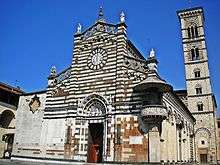
Understand
Prato is the low-profile cousin of Florence and Pisa in the Central Italy region of Tuscany. Not as mobbed with tourists and without the typical tourist ripoffs it nonetheless has a history and artistic heritage dating back to the Etruscan civilisation and everything since, plus great food. It's a great place to stay and save a few euros while doing day trips to Pisa or Florence.
As regards the area, Prato is a city that is part of the north-east and covers about 100 km². Located at the foot of the mountain of Retaia, it is bisected by the Bisenzio River, a tributary of the Arno.
- 🌍 Tourist Information Office, Piazza Buonamici, 7, ☎ +39 574 24112. Open daily.
Get in
By plane
The nearest airports are Galileo Galilei di Pisa close to Pisa and Amerigo Vespucci di Firenze close to Florence.
From the airport of Pisa to Prato
The train station at Pisa airport is directly connected with the Santa Maria Novella station in Florence and Pisa Central Station (line Pisa - Lucca - Pistoia - Florence). The airport is very close to the Pisa Nord motorway. From the Pisa Nord motorway take the A11 motorway and continue towards Florence. West Lawn toll is about 65 km from Pisa, while the exit Prato Est is about 73 km away.
From the airport of Florence to Prato
The Amerigo Vespucci Airport is located in Peretola and is as close to the province of Prato. The airport is not directly connected to the railway line. You can reach the station of Firenze Santa Maria Novella and Florence Rifredi using the bus. Arriving by car from Florence in Prato is very simple: the airport is the A11 motorway exit "Firenze Nord", which is only 5 km from the exit Prato Est and 13 km from the exit West Prato. There is a bus service between the airport and Prato (Prato Central Station) operated by Cap Autolinee Prato.
By car
Driving in Italy is not for the faint-of-heart and Prato is no exception especially in the old center of the city where the city walls, narrow streets, and ubiquitous pedestrian zones make navigating and parking particularly difficult.
By train
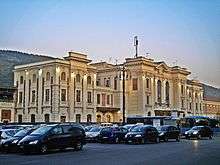
There are three train stations in Prato. The main station 🌍 Central Station of Prato is a large railway station and located on the Florence-Bologna and Florence-Prato-Pistoia-Lucca-Viareggio lines.
The station 🌍 Prato Porta al Serraglio is a railway station railway Maria Antonia. Least, is the second station in the city of Prato. Among the three stations of the city is the closest to the old town, being only five minutes walk from Piazza del Duomo.
The station of 🌍 Prato Borgonuovo is a small station on the outskirts of the city of Prato. It is located on the Florence-Prato-Pistoia-Lucca-Viareggio, has two tracks and two small loops shelters. On the first track passing convoys for Pistoia, Lucca and Viareggio. While the second track the convoys to Prato Central and Firenze Santa Maria Novella. Only regional trains stop.
Get around
By bus
Cap Autolinee Prato operate five lines:
- LAM blu (blue): Repubblica - Centro Città - Maliseti
- LAM arancio (orange): Stazione Centrale - Piazza Carceri - Piazza San Domenico - Galciana
- LAM rossa (red): Galceti - S. Lucia - Centro Città - Paperino - S. Giorgio - S. Giusto
- LAM-MT viola (purple): Prato - Montemurlo - Montale - Oste - Agliana
- LAM-MT azzurra (light blue): Prato - autostrada A11 - Firenze. This line goes to Firenze via the airport.
- LAM-MT azzurra (light blue): Prato - Poggio a Caiano - Comeana - Seano - Carmignano
See route map for details and timetables. All of the above lines have a stop near the main train station Stazione Centrale and pass through the city centre/historic centre (centro città or centro storico).
By foot
The old centre can easily be discovered by foot.
By taxi
Taxis can be typically found at Piazza Duomo, Piazza Stazione and Via Cavour. You can also call a taxi with this number: +39 574 5656.
See
Churches
- 🌍 Duomo of Prato (Cathedral of Santo Stefano) (leaving the Piazza of Comune and leaving along the Corso Mazzoni you reach the large Piazza del Duomo). At the large Piazza del Duomo is the Cathedral of Santo Stefano. A splendid example of Romanesque - Gothic Tuscan, the Cathedral is characterized by clever use of two colors on alberese clear and serpentine green marble from Prato, typical materials of the town until 1400. On the right side of the front is the famous pulpit, built between 1433 and 1438 by Michelozzo and decorated by Donatello. The pulpit was designed specifically for the Exposition of the Holy Girdle of the Virgin Mary, preserved in the chapel inside the Basilica. There are splendid, precious frescoes of the "Dance of Salome" by Filippo Lippi in the Cappella Maggiore.
- Bishop's Palace. Adjacent to the cathedral is the Bishop's Palace (14th-17th century), part of which is occupied by the Museo dell'Opera del Duomo.
In the territory of Prato, probably since the eighth century, there was a reorganization of the Church with the division into districts that were owned by new churches, the churches (from plebs, the people, namely the community of the baptized), with the baptismal font. The churches listed below are those that were already in medieval churches and are included in the diocese of Prato:
- San Giusto in Piazzanese
- San Lorenzo a Usella
- San Michele a Montecuccoli
- San Pietro a Figline
- San Pietro a Iolo
- San Vito e San Modesto a Sofignano
- Santa Maria a Colonica
- Santa Maria a Filettole
- Sant'Ippolito e San Cassiano
- Sant'Ippolito in Piazzanese
Prato was long known as "City of the Virgin" for the strong Marian devotion that, initially linked to the veneration of the Sacred Belt, then grew with the construction of shrines dedicated to Our Lady (three parishes are today), these are is recently added one dedicated to St. Anthony Mary Pucci.
Monuments
- Fourteenth-century walls. Within these gathered almost all the major historic buildings. The hexagonal circuit of the walls enclosing the original core city of Prato, dotted with ancient tower houses.
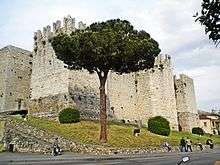
- 🌍 Castello dell'Imperatore (Emperor's Castle). Fortress, also known as Santa Barbara or Swabian castle, can be considered the most important architectural evidence of the 9th-13th centuries.
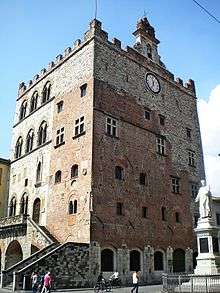
- Piazza del Comune. Created at the end of the 13th century, the intersection of two main roads of the city. In the central area of the square is the Fountain of Bacchino, which was cast in bronze between 1659 and 1665 by Ferdinando Tacca, during the recognition status of city of Prato. In front of City Hall (located in the square) is also found in white Carrara marble statue dedicated to the merchant of Prato, Francesco Datini Antonio Garella (1896).
- 🌍 Palazzo Comunale (Town Hall), Piazza del Comune, 2 (overlooking Praetorian Palace), ☎ +39 574 1836220. It was created as the seat of the priors, linking different buildings. It houses the Town Hall. In the hall of the Municipal Council are held two frescoes of the 14th century, representing an Allegory of Justice and Majesty. Inside the building are kept several portraits of the Podestà of Prato and the Granduchi of Tuscany.
- 🌍 Palazzo Pretorio and Museum (Praetorian Palace), Piazza del Comune, ☎ +39 574 1934996, +39 574 1837860 (on weekends). Mon, Wed-Sun 10:30-18:30 (last admission at 18:00), Tue closed. The old Town Hall Lawn, located in the town square opposite of the current Town Hall. Since 1912 it has housed the Museo Civico. After major restoration works the palace and museum opened again in 2013 to the public. €8.
- 🌍 Datini Palace, Via Ser Lapo Mazzei, 43, ☎ +39 57421391. It was the home of the famous merchant Francesco di Marco Datini (Prato 1335-1410). He leaves an important witness to himself, made up of records and correspondence, which constitute a substantial fund today filed with the State Archives of Prato, which is housed in the old house.
- 🌍 Sculpture by Henry Moore (Large Square Form with Cut), Piazza San Marco. This is one of many contemporary works of art that the city hosts. The square-shaped cut of the famous contemporary sculptor Henry Moore.
Museums
- 🌍 Centro per l'Arte Contemporanea "Luigi Pecci", Viale della Repubblica 277, ☎ +39 574 5317.
- 🌍 Museo dell'Opera del Duomo. This museum is adjacent to the cathedral and occupies parts of the Bishop's Palace (14th-17th century).
- 🌍 Museo del Tessuto (Textile museum), Via Puccetti 3, ☎ +39 574 611503.
- Fondazione Museo e Centro di Documentazione della Deportazione e Resistenza, Via di Cantagallo, 250 (in Figline) (Take bus 12A from Piazza San Domenico. It stops in front of the museum), ☎ +39 574 470728. Museum of Deportation and centre of documentation.
- Galleria virtuale. art museum of "Images of the sacred" permanent exhibition.
- Quadreria. collection of paintings held in the Town Hall.
- Museo di pittura murale.
- Centro di Scienze Naturali.
Do
- 🌍 Teatro Metastasio, Via Benedetto Cairoli, 59. Venue for operas, theatre plays and concerts. Built in 1830.
- 🌍 Teatro Politeama Pratese, Via Garibaldi, 33/35.
- Corteggio storico di Prato (Festa dell'8 settembre). Annual event in September
Buy
- 🌍 Biscottificio Antonio Mattei, Via Ricasoli, 20, ☎ +39 574 25756. Mon closed. Has made delicious biscotti di Prato since 1858.
- There is a large Coop supermarket near Piazza San Marco between the historic city centre and the main train station.
Eat
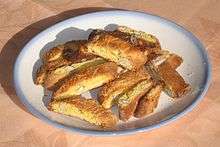
Prato is the wellspring of biscotti di Prato, also called cantuccini, so why not indulge while you are there? They are commonly accompanied by vin santo, a Tuscan dessert wine.
- Ristorante Amalfi, via Strozzi, 207, ☎ +39 338 8917671, +39 0574 483010.
- Ristorante Pizzeria Da Giovanni - Cavallino Rosso, v. Pistoiese, 26, ☎ +39 0574 23143, e-mail: ristorantedagiovanni@hotmail.com.
- Mangia, v. Ferrucci, 173, ☎ +39 0574 572917, e-mail: info@enosteriamangia.it. Tu-Su 19:30-24:00. Pizza €6-10. Mains €13-18.
- Ristorante Pizzeria Il Mercante, v. Traversa il Crocifisso, 47, ☎ +39 0574 627174, e-mail: info@ristoranteloscoglioprato.it. M-Sa 12:30–15:00, 19:30–23:00. Mains €12-35.
- 🌍 Ristorante Pizzeria Lo Scoglio, Via Verdi, 42, ☎ +39 574 22760. Daily 19:15-24:00.
- Fancy King - Ristorante Pizzeria, v. Valentini, 21, ☎ +39 0574 581343, e-mail: gralu67@hotmail.it. M-F 12:30–15:00, 19:30–24:00; Sa-Su 19:30–24:00.
- Pizzeria Il Ragno, v. Valentini, 133, ☎ +39 0574 596700. Di Adorni Eraldo & C. s.n.c.
- Ristorante Pizzeria Il Piccolo Borgo, v. Ferro, 390/b, ☎ +39 0574 643060, fax: +39 0574 072872, e-mail: info@ilpiccoloborgo.com. M-F 12:00–14:30, 19:00–24:00; Sa 19:00–24:00. Pizza €7-13, mains €12-20.
- Prota Catering, v. Guinizelli, 20, ☎ +39 0574 634478, fax: +39 0574 638079, e-mail: info@protacatering.it.
- Don Chisciotte, Viale Galileo Galilei, 21, ☎ +39 0574442903.
- Il Pirana, Via Giuseppe Valentini, 110, ☎ +39 574 25746.
- Pepe Nero, Via Zarini 289, ☎ +39 0574 550353.
- Ristorante Pizzeria Sancho Panza, Via Giuseppe Valentini, 39, ☎ +39 0574757383.
- Enoteca Ristorante Razmataz, Piazza Mercatale, 107, ☎ +39 0574 448619.
- Il Palazzolo, Via Mazzini Giuseppe, 37, ☎ +39 0574 400730.
- Pizzeria Re Nudo, Via Baldinucci Quirico, 3, ☎ +39 0574 27720. Closed Monday. Di Quattrocchi Domenico.
- La Vecchia Cucina di Soldano, Via Pomeria, 23, ☎ +39 0574 34665.
Drink
- Babaloo, Via Roma, 2/4 (Porta S. Trinita), ☎ +39 0574 448600. Ristorante bar pub.
- Cencio's, Via Strobino 1., ☎ +39 0574 580788.
- Controsenso, Via Dino Saccenti, 31/33 - Prato, ☎ +39 393 1151351, e-mail: info@contro-senso.it. Free admission for members ACSI. Concerts start at 23:00. Closed: Monday and Tuesday.
- Enoteca Razmataz, Piazza Mercatale 107/108/110, ☎ +39 0574 448619, +39 338 5690611 (Cellulare), +39 393 0521015, e-mail: enotecarazmataz@yahoo.it. Tu-W 7PM–12:30AM, Th 7PM–1AM, F-Sa 7PM–1:30AM. Tu-W prix fixe menu for €20 with reservation.
- Exenzia Club, Via Ettore Sambo, 10, ☎ +39 336 3722344, +39 333 3546607, e-mail: exenziaclub@exenzia.it. F-Sa 9PM-3AM. Rock club with concerts of various kinds. Smoking area inside. Free admission for members ACSI.
- Hop Store, Via Terracini, 11, ☎ +39 0574 440629. Beers from Italy, the UK, Belgium and Germany.
- I Francescaioli, Piazza San Francesco 8, ☎ +39 0574 607499, +39 348 7723940, e-mail: infoifrancescaioli@yahoo.it. Daily 08:00-16:00, 19:00-24:00. Ristorante - pizzeria - pub Mains €8-13, pizza €4.50-8.50.
- Kellerplatz, Via Migliorati, 7, ☎ +39 0574 41364. Concerts and live music.
- Le Barrique, fax: +39 0574 30151, e-mail: info@lebarriquewinebar.it. Wine bar: Via G. Mazzoni, 19 - Prato. Aperitif every evening. Wine-tasting.
- Palasport Bowling Prato, Via F. Ferrucci 309, ☎ +39 0574 591310. M-Th 8:30PM–1AM, F 8:30PM–2AM, Sa 3:30PM–2AM, Su 3:30PM–1AM.
- Pub Mostodolce, Via Dell' Arco, 6., ☎ +39 0574 21973. M-W 19:30-02:00, Th-Sa 19:30-02:30.
- Siddharta, Via Traversa Pistoiese, 83, ☎ +39 0574 35906. alternative club
- Wallace GastroPub, Piazza Mercatale, 24, ☎ +39 0574 442003. Su-Th 11:00-02:00, F-Sa 11:00-03:00.
Sleep
- Charme Hotel, v. Badie, 228, ☎ +39 0574 553706, +39 0574 550541, fax: +39 0574 597606, e-mail: info@charmehotel.it. di Sogeneral srl. Buffet breakfast included single €70-130, double €90-170.
- Hotel Trendy, v. Pistoiese, 833, ☎ +39 0574 799990, fax: +39 0574 798447.
- Wall Art Hotel : Viale della Repubblica, 4/6/8. Tel: +39 0574 389981, +39 0574 596600, fax: +39 0574 575335.
- B & B Il Bagnolo :v. Labriola, 174. Tel: +39 0574 654335, +39 345 2547747, fax: +39 0574 654335, email: info@bbilbagnolo.it .
- Albergo Giardino :v. Magnolfi, 4. Tel: +39 0574 26189, +39 0574 606588, +39 0574 606576, fax: +39 0574 606591, email: info@giardinohotel.com .
- Albergo "Il Giglio", Piazza S. Marco, 14, ☎ +39 0574 604351.
- Albergo "Le Fontanelle", Traversa Il Crocifisso, 6, ☎ +39 0574 623692.
- Art Hotel, Viale Della Repubblica, 272, ☎ +39 0574 5787.
- Datini Hotel, Viale Marconi Guglielmo, 80, ☎ +39 0574 562348.
- Flora Hotel : Via Cairoli Benedetto, 31. Tel: +39 0574 33521, +39 0574 400289, email: info@hotelflora.info .
- Golf Residence di Residence Golf Hotel S.R.L.: Traversa Il Crocifisso, 24/N. Tel: +39 0574 621054, +39 0574 623195.
- Hotel President, Via Simintendi Arrigo, 20, ☎ +39 0574 30251.
- Hotel San Marco, Piazza S. Marco, 48, ☎ +39 0574 21321. single €60-67, double €85-90, triple €99.
- Hotel Toscana Hotel, Piazza Ciardi Giovanni, 3, ☎ +39 0574 28096, fax: +39 0574 25163.
Go next
- Florence, right next door, is the obvious place for day trips
- The hill town of Fiesole is another neighbour of Florence, with its own Etruscan-to-now history and charm.
- Lucca — Puccini's birthplace; beautiful old town surrounded by ancient walls
- Pisa — for the world famous Leaning Tower and the rest of the Campo dei Miracoli
- Siena, a Medieval city with a unique character, history and great artistic heritage